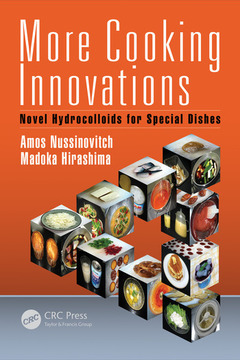Description
More Cooking Innovations
Novel Hydrocolloids for Special Dishes
Authors: Nussinovitch Amos, Hirashima Madoka
Language: English
Subject for More Cooking Innovations:
Keywords
Native Whey Protein Isolate; Soy Protein; water-soluble polymers; Mesquite Gum; biosynthetic gums; Preparation Hints; emulsifiers; Gum Ghatti; stabilizers; Baking Paper; texturizers; Worcestershire Sauce; gelling agents; Soluble Soybean Polysaccharides; Madoka Hirashima; Bacterial Cellulose; Gellan Gum; Gum Karaya; Gum Tragacanth; Water Soluble Gums; Gum Exudates; Soybean Flour; Low Fat Ice Cream; White Sugar; Long Chain Inulin; Pullulan Solution; Inulin Powder; Poly-phosphoric Acid; Sugar Snap Cookies; Sodium Caseinate; Xanthan Gum Powder; Soybean Milk
Approximative price 271.33 €
In Print (Delivery period: 14 days).
Add to cart· 15.2x22.9 cm · Hardback
Description
/li>Contents
/li>Readership
/li>Biography
/li>
Hydrocolloids are among the most commonly used ingredients in the food industry. They function as thickeners, gelling agents, texturizers, stabilizers, and emulsifiers, and have applications in the areas of edible coatings and flavor release. This book More Cooking Innovations: Novel Hydrocolloids for Special Dishes completes the very demanding task begun with our previous book: "Cooking Innovations, Using Hydrocolloids for Thickening, Gelling and Emulsification" of covering all hydrocolloids that are or will be very useful and important in the kitchen.
Together, these books provide a complete picture of hydrocolloid use in foods, both in the kitchen and for food technologists and academics. The book includes several very important hydrocolloids, among them: chitin and chitosan, gum karaya, gum tragacanth, and milk proteins. Additional chapters comprise unique hydrocolloids which, in our opinion, will not only be used in future cooking (by both amateur cooks and professional chefs), but can pave the way to new and fascinating recipes and cooking techniques. The book also discusses novel hydrocolloids?the "where, why, and when" as well as future ideas for hydrocolloid processing and cooking. This book therefore describes more cooking innovations, and completes the list of hydrocolloids that are now, or will be used in kitchens and cooking for years to come.
1 Novel hydrocolloids—where, why and when? 2 Arabinogalactan. 3 Bacterial cellulose. 4 Cereal -glucan. 5 Chitin and Chitosan. 6 Dextran. 7 Gum ghatti. 8 Gum karaya. 9 Gum tragacanth. 10 Inulin. 11 Larchwood arabinogalactan. 12 Levan. 13 Mesquite gum. 14 Milk Proteins. 15 Other Microbial Polysaccharides: Alternan, Elsinan, Levan, and Scleroglucan. 16 Pullulan. 17 Soluble soybean polysaccharide. 18 Vegetable protein isolates. 19 Xyloglucan. 20 Future ideas for hydrocolloid processing and cooking.
Professor Amos Nussinovitch was born in Kibbutz Megiddo, Israel. He studied Chemistry at the University of Tel Aviv, and Food Engineering and Biotechnology at the Technion – Israel Institute of Technology. He has worked as an engineer at several companies and has been involved in a number of R&D projects in both the United States and Israel, focusing on the mechanical properties of liquids, semi-solids, solids and powders. He is currently at the Biochemistry and Food Science Department of the Robert H. Smith Faculty of Agriculture, Food and Environment of the Hebrew University of Jerusalem, where he leads a large group of researchers working on theoretical and practical aspects of hydrocolloids. Prof. Nussinovitch is the sole author of the books: Hydrocolloid Applications, Gum Technology in the Food and Other Industries; Water-Soluble Polymer Applications in Foods; Plant Gum Exudates of the World Sources, Distribution, Properties, and Applications; Polymer Macro- and Micro-Gel Beads – Fundamentals and Applications; Adhesion in Foods, Fundamental Principles and Applications. He and his present co-author Dr. Madoka Hirashima (see below) recently co-authored the book: Cooking Innovations, Using Hydrocolloids for Thickening, Gelling, and Emulsification. Prof. Nussinovitch is the author or co-author of numerous papers on hydrocolloids and on the physical properties of foods, and he has many patents. This book is devoted specifically to more cooking innovations: specifically, using traditional and numerous novel hydrocolloids for special dishes. The author has been working in this area for many years and has studied gel textures and structures, textures of hydrocolloid beads and texturized fruit, liquid-core hydrocolloid capsules, different hydrocolloid carriers for encapsulation, novel hydrocolloid cellular solids and edible hydrocolloid coatings of foods, among many other applications. Several years ago, Prof. Nussinovit




